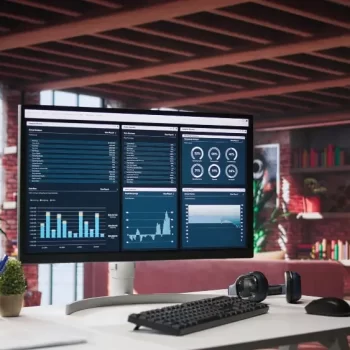Modern IT environments are vast, distributed, and constantly evolving. As infrastructure grows more complex, traditional monitoring tools that only react to failures fall short. Predictive monitoring changes the equation by forecasting issues before they impact performance or availability.
By combining infrastructure monitoring with real-time insights from predictive analytics, IT teams can follow intuitive steps to reduce downtime, optimize resources, and maintain uptime across digital systems.
This blog explores what predictive monitoring is, how it works, and the key strategies to make it work better in real-world environments.
What is Predictive Monitoring in IT?
Predictive monitoring uses data trends and historical patterns to identify risks before they affect services. Instead of waiting for an alert after an outage, this approach anticipates failure points and degradation signals early.
In IT, predictive monitoring spans systems, networks, cloud infrastructure, and applications. It helps detect anomalies in behavior, such as memory spikes or unusual disk latency, before they lead to actual breakdowns. This stands in contrast to reactive models, where alerts only fire once thresholds are breached or downtime occurs.
How Predictive Analytics and Tools Enhance Predictive Monitoring
Predictive analytics refers to data science techniques that identify future trends using current and historical data. In monitoring, these models can forecast events such as:
Server CPU exhaustion based on usage trends
Disk failures based on read/write anomalies
Application crashes linked to specific patterns in logs
When tied into IT monitoring, AI predictive analytics plays a central role. It finds patterns that humans or basic rule-based systems would miss. For example, instead of flagging a high CPU usage event after it happens, analytics may notice subtle increases over days and raise an early signal.
This shift reduces firefighting and increases control.

Key Challenges in Predictive Monitoring with AI and Predictive Analytics
While promising, predictive monitoring comes with its hurdles:
Data drift and concept drift
Model accuracy drops when data sources change or usage patterns shift. What was true yesterday may no longer hold.
Inaccurate or insufficient data
Poor-quality logs, missing metrics, or limited telemetry reduce model confidence.
Lack of integration across tools
Siloed systems block visibility across the stack, leading to blind spots.
Low visibility into infrastructure components
Without full-stack observability, predictions lose context or get misclassified.

Top Strategies to Optimize Predictive Monitoring with Predictive Analytics Tools
1) Implement real-time infrastructure monitoring
Start by enabling continuous infrastructure monitoring. This includes capturing data from virtual machines, containers, APIs, storage nodes, and switches. The wider and deeper the visibility, the better the foundation for analytics. Real-time collection reduces blind spots and increases the speed at which potential issues are identified.
2) Use high-quality, diverse data sets
Predictive analytics thrives on volume, variety, and quality. Include metrics from system health, logs, network traffic, user sessions, and API performance. More contextual data improves model outputs. Diverse data also improves the ability to generalize and predict rare or edge-case failures.
3) Monitor for data and concept drift
Trained models degrade if the environment they were built for evolves. Regularly test for drift: both in terms of data structure and outcome variables. Set automated checks to alert teams when inputs no longer align with model assumptions.
4) Leverage AI-powered predictive analytics tools
Use platforms that apply AI predictive analytics such as anomaly detection, clustering, and time-series forecasting. These tools adapt to dynamic workloads, helping spot issues even during scaling or cloud migrations. Look for models that update automatically, support explainability, and integrate into dashboards and alert systems.
5) Perform continuous model monitoring and updates
No model performs well forever. Create a process to track metrics like precision, recall, and false positives over time. Schedule retraining based on drift or predefined intervals. Use version control for both models and data inputs.
6) Conduct root cause analysis
Predictive monitoring should not stop at early alerts. Integrate tools that trace incidents back to their origin, be it code, config, or third-party services. Root cause analysis helps avoid repeat failures and improves model refinement. It also strengthens feedback loops between operations and development.
7) Enable proactive alerting and auto-remediation
When the system predicts trouble, it must also act. Connect forecasts to automation workflows that reroute traffic, spin up new resources, or throttle usage preemptively. Smart alerting with auto-remediation closes the loop between detection and response.

How Predictive AI and Predictive Analytics Tools Enhance Monitoring
Predictive AI brings scale and adaptability to monitoring systems. Techniques like neural networks, unsupervised learning, and time-series modeling extend beyond simple thresholds. They process massive streams of telemetry and learn behaviors that precede incidents.
By embedding AI predictive analytics into the fabric of monitoring, IT teams gain forward-looking insight into stability, capacity planning, and user impact. Over time, this builds a self-improving operations model.
Top Benefits of Predictive Monitoring with Predictive Analytics
Reduced downtime: Early detection lowers incident counts and shortens impact windows
Better resource utilization: Predict trends in demand and scale environments intelligently
Cost savings: Avoid overprovisioning and reduce SLA penalties through proactive actions
Higher reliability: Spot bottlenecks and risks before they impact availability
Improved customer experience: Fewer slowdowns or disruptions translate to better retention and satisfaction
Infraon’s Predictive Monitoring Solution with Integrated Predictive Analytics Tools
Infraon IMS delivers AI-driven monitoring for hybrid IT environments. It includes modules for infrastructure monitoring, threshold alerting, predictive diagnostics, and automation. So, teams use it to collect telemetry across data centers, clouds, and applications.
It integrates predictive models into alert systems, supports custom thresholds, and auto-escalates based on risk scores. The module enables smarter visibility, lower downtime, and reduced overhead for ITOps teams.
Need more AI power in your ITOps monitoring capabilities? Please write to marketing@infrao.io
FAQs About Predictive Monitoring and Predictive Analytics in IT
What is the difference between predictive monitoring and predictive analytics?
Predictive monitoring applies predictive analytics to IT systems. While analytics can be used in any field (marketing, finance, etc.), monitoring uses it to forecast and avoid performance or stability issues in infrastructure and applications.
How does AI improve predictive monitoring?
AI models process more data, learn from patterns, and adapt faster than manual systems. In monitoring, this translates into earlier alerts, better accuracy, and the ability to detect issues traditional tools would miss.
What are common KPIs for predictive monitoring?
Key metrics include model accuracy, incident prediction rate, false positive rate, mean time to detect (MTTD), and reduction in unplanned downtime.
What tools are commonly used for predictive infrastructure monitoring?
Tools include AIOps platforms, custom ML pipelines, cloud-native monitoring tools with forecasting modules, and integrated platforms like Infraon IMS that combine telemetry with analytics.
How often should predictive models be retrained?
Retraining depends on environment changes. Most models should be reviewed quarterly or after a major infrastructure shift. Drift detection tools can signal when retraining is required sooner.












